Expand Contents
If you search online for information about variegated plants, you’ll find plenty of blog posts offering to explain how variegation works and describing two or three different types. I’ve read lots of those posts, both when I was first learning, and more recently when I’ve wanted to explain things to other people. But they’ve never been satisfactory.
To understand plant colour and variegation, we need to consider two factors: the how, and the why.
- The how factor is the question, “What physical and chemical processes inside the leaf created the colours we see?”
- The why factor is the question, “What caused those physical and chemical processes to happen in that way?”
Most simplified explanations don’t distinguish between these two factors, and end up giving information that’s either unhelpfully ambiguous or outright incorrect.
In this article I’ll explain the different possible answers to both the how and why questions. Then I’ll cover lots of familiar variegated patterns and explain the factors they arise from. And I’ll end by looking at one particular cultivar and showing the different types of variegation it has. But first, I’m going to start by defining some important terms that I’ll keep coming back to.
This is an unapologetically long article! You can use the links in the contents list above to get to particular sections. There are also links to other sections within the article, so you can jump around the parts that interest you. After you click a link to a different section of the article, your browser’s back button should take you back to your previous spot on the page.
Thanks to Sam Rowe for the diagrams and illustrations!
Some important definitions
What is a variegated plant?
In its broadest sense, a variegated plant is one that shows multiple colours on its foliage. This multi-coloured pattern is called variegation.
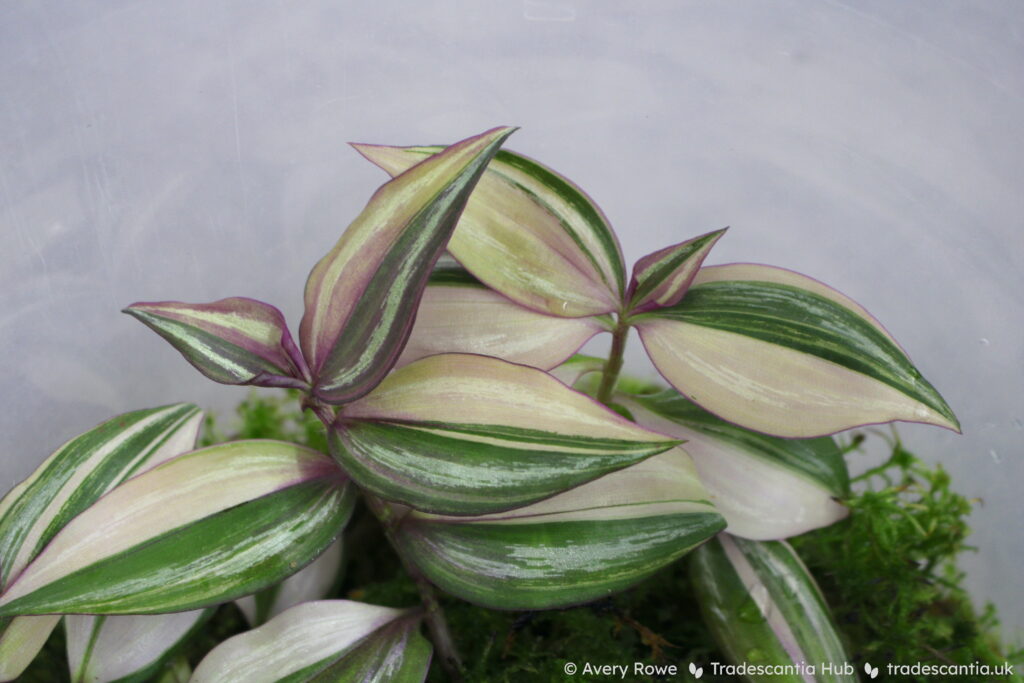
A variegated plant might show two different colours, or even more. One of the colours is often green, but they can also include white, yellow, purple, silver, and many shades in between. The pattern may be regular and distributed the same way on each leaf, or random and variable. And these patterns can be created and caused in many different ways.
In common use, most people exclude certain things from the meaning of “variegated”. When a leaf starts turning partially yellow from old age – we generally don’t call that variegation. In botany, descriptions of variegation are often restricted to species which have naturally-occurring patterns in the wild. Whereas in horticulture it’s sometimes the other way round, with growers only using “variegated” to refer to unusual mutations and cultivars.
As is common, these different contextual uses of the same words sometimes lead to confusion and misunderstandings. In this article I aim to cover everything that could be considered variegation, and provide more specific terms to clear up ambiguity.
What is a sport?
In horticulture, a sport mutation (or just sport) is part of a plant that has spontaneously started to show some kind of mutated growth.
Sport mutations happen at random. Some factors can make mutations more likely to happen – like radiation or chemical treatments. But there’s no way to control what mutations might happen, if they do. The mutation always starts from one single cell. Depending on the location of that cell, it may divide to create new growth where all those cells have the same mutation.
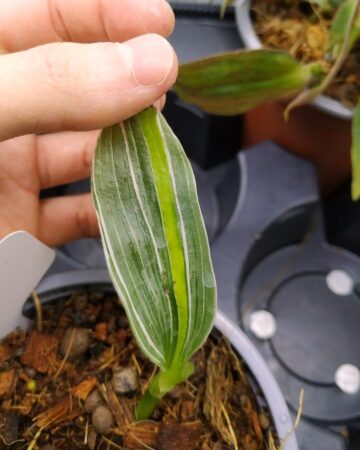
Sometimes when a sport appears, the change is just visible in one leaf or flower, and it doesn’t last. Other times, the mutation stays consistent in the new growth. Some people assume that a new sport must be unstable and will always revert. But in fact, the mutation that shows up in a sport can be as stable or unstable as any mutation that has existed and been propagated for a long time. The fact it was just discovered doesn’t have any effect on how it might behave over time.
Sport mutations can involve all kinds of different traits. For example, a plant might make one branch with different-coloured flowers. But the most common (and the most relevant for this article) is when a plain green plant starts making variegated leaves. If the variegated pattern carries on in the new growth, it can be propagated through cuttings. This is how many popular variegated cultivars first originated.
What is a reverted plant?
In horticulture, a reverted plant is one that used to have some kind of mutation, but has spontaneously lost it and permanently returned to its ancestral appearance. The process of becoming reverted is called reverting or reversion.
Reversion happens at random. In some cultivars, certain growing conditions (like light levels) can make reversion more or less likely. Some types of mutation are more prone to reversion than others, even in perfect conditions.
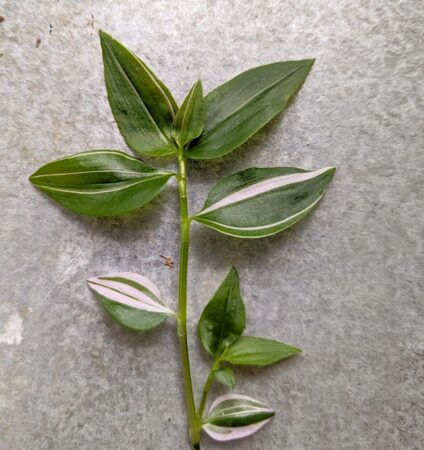
Mutated cultivars are almost always somewhat weaker and less vigorous than the natural wild form of the species. (If the mutation was stronger than the wild species, then it would have evolved and taken over in the wild already!) So when growth occasionally returns to the wild form, the new reverted part will grow faster and stronger. If it’s not removed, it will tend to take over the whole plant until the mutation is lost completely.
The mutation which reverts can be anything. For example, sometimes dwarf trees will revert and suddenly start making full-sized branches. But the most common example is a variegated cultivar of a usually-green species, which starts growing plain green shoots again.
Not all variegated patterns can revert. It depends on what causes the pattern in the first place (which we’ll cover in more detail later). Some patterns are inherent to the species, and so there is no ancestral appearance to return to. Other patterns are caused by external factors and can freely disappear and then reappear when conditions are right. Reversion only refers to plants which had a mutation and have permanently lost it. Sometimes a pattern which can’t revert (or which can, but only does so very rarely) is described as stable.
What is chlorosis?
Healthy chlorophyll is an essential feature of a healthy plant. Because it’s so important, it can be affected by many different things. If a plant has damage or disease which destroys or prevents the production of chlorophyll, parts will start to turn yellow. This yellowing is called chlorosis.
Chlorosis can have lots of possible causes – from mechanical damage, to disease, to nutrient imbalances.
How do plants get their colour?
Looking at just a handful of different Tradescantia stems will show how colourful plants can be. And the same variation can be found all through the plant kingdom.
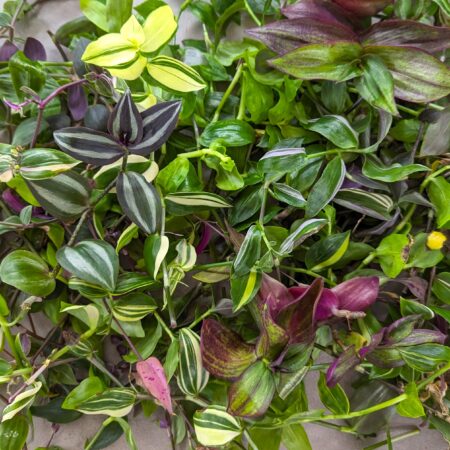
But when you get up close, all those possible colours actually arise from a small number of different microscopic traits. Any part of a leaf can have any combination of those traits, and so there are a surprising number of possible results.
For our purposes here, I’m classifying the traits that contribute to plant colours into three categories:
In reality, each of those categories contains various different examples which create subtly different results. But they behave similarly enough that it’s simplest to group them like this.
Here’s a representation of how three traits which can be present or absent will create eight combinations, each with a different colour appearance. And this doesn’t even include the subtleties of slightly different types of pigment, or the variation in how much is present in a leaf.
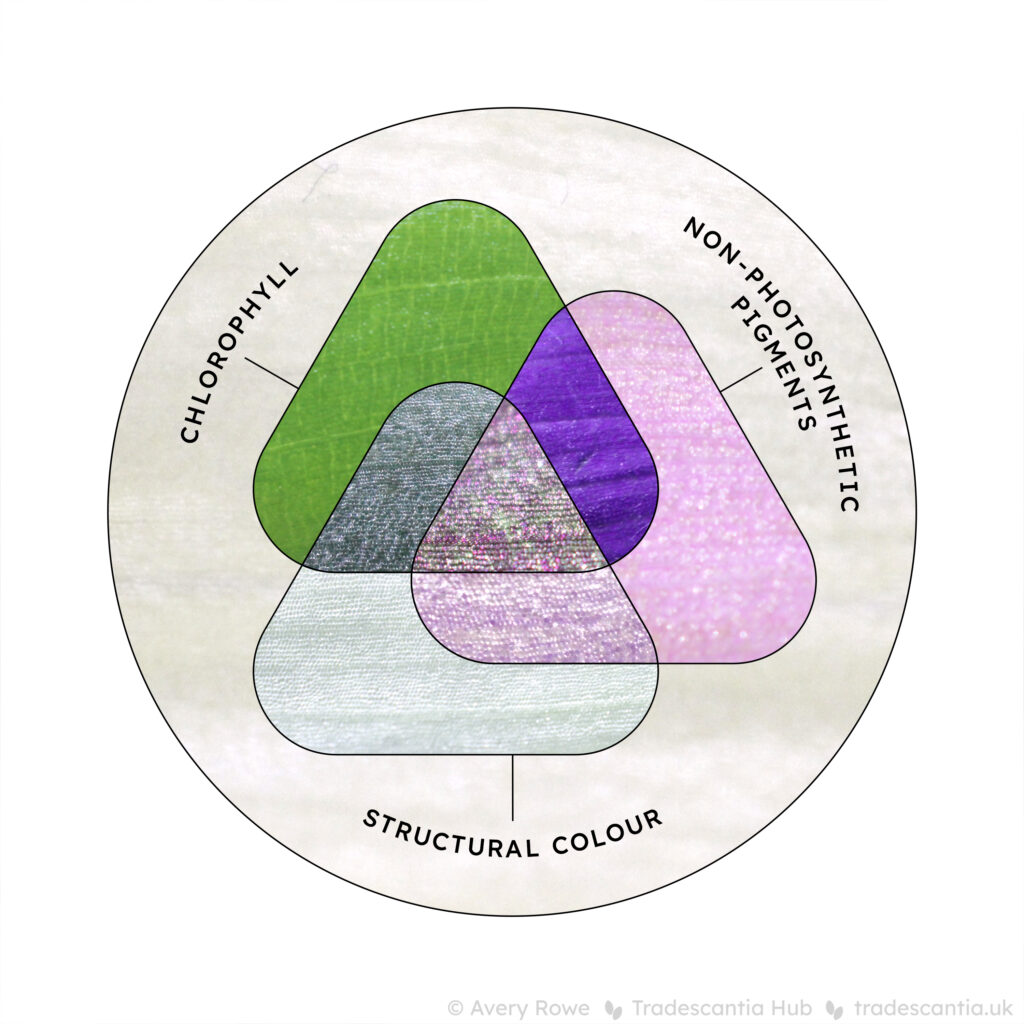
Chlorophyll
Chlorophyll is the best-known trait that gives plants their colour – it’s the pigment that makes plants green. It’s an organic molecule which is essential to photosynthesis, the process plants use to convert sunlight into chemical energy for growth. Large amounts of chlorophyll are present in almost all plants. (There are just a tiny handful of exceptions, like parasitic species which get their energy from other plants instead.)
When chlorophyll is present in a leaf, it contributes a green colour. More chlorophyll means a deeper and stronger green. If it’s present only in small amounts, it can create light green or yellow shades. And when it’s completely absent, there’s no green at all – the tissue will be white if there are no other colours present.
Non-photosynthetic pigments
Plants can produce pigments – coloured chemical compounds – that aren’t involved in photosynthesis like chlorophyll is. There are various different types of pigments, but I’m grouping them all together here because they behave similarly. Different plants use and distribute pigments in different ways.
The pigments themselves range between yellow, orange, red, and purple. When they’re present in large amounts alongside chlorophyll they can create very intense tones from bright red to blackish-purple. In smaller quantities they create greyish or brownish greens. When they’re completely absent, there are no warm tones at all. And when there are pigments but no chlorophyll, the tissue can become bright pink or orange.
Structural colours
This trait is different from the others. If you mash up a green or purple leaf, you’ll end up with green or purple goo, because the colour is caused by chemical compounds which have a colour of their own (pigments). Structural colours are all the visual effects that aren’t caused by coloured pigments – if you mash up a leaf with areas of structural colour, the goo won’t be that colour at all.
Instead the different appearance is created by the structure and arrangement of cells in the intact leaf, so when that structure is destroyed the colour is gone. Sometimes this involves areas of cells which are larger or smaller, or have walls of different thicknesses and textures. But most commonly it’s caused by having a tiny air gap between the top layers of cells on the leaf.
These structural colours change the way that light reflects from the leaf, and so change its overall appearance. The result is usually a glittery or iridescent surface, and sometimes a white or grey sheen overlaid on the other pigments in the leaf.
Why are plants variegated?
We can analyse the colours of a variegated leaf by taking each individual section and considering which traits from above apply to it – does this part have structural colour? does that part have non-photosynthetic pigments? But that would still only tell us about what creates the individual colours. To fully understand the variegation, we also need to know why those colours are created in the patterns we see.
There are lots of different possible causes for variegated patterns. This section will cover each of them fairly briefly. We’ll come back to them in more detail when we look at specific types of variegation that arise from these causes.
Genetics of the species
Genetics are the internal blueprints which tell every organism how to grow and reproduce. Each organism gets half of its genetics from each parent, and passes them on to its own offspring.
All living species develop through evolution – billions of years of trial and error through random mutations and combinations of genes. Each species alive today has evolved to survive the environment it lives in, and stored the instructions for how to do that in its genetics. Along with many other important instructions, genetics define the colours, patterns, and structures on the leaves of each particular species.
Genetics of the individual
Genetics define the species a plant belongs to. But that doesn’t mean that every individual plant of the same species is identical, any more than every human is identical. As I’ve talked about in other articles, a wild species is a group of plants which has a natural range of variation in traits. The species’ evolutionary history provides a broad range of possibilities for any trait, and each individual is on a particular spot in that range.
Sometimes an individual plant can also have genetic mutations that are outside of the normal range for the wild species. These random mutations are how species are able to evolve major changes over time (although the vast majority of mutations have a neutral or negative impact, and don’t end up defining the future of the species).
Chimeras
Usually, one single organism has one single set of genetics which it gets from its parents. In contrast, a chimera is a single organism which has a mixture of multiple different sets of genetics within the same individual.
Plants grow continuously throughout their lives, unlike animals. That means that if one cell in the growing point of a plant develops a random mutation, it can multiply and continue in the new growth. If some of the cells multiplying in the new growth have that mutation and some don’t, the result is patchwork mixture of the two – a chimera. And if one of the sets of genetics in the chimera is a mutation which causes a visible colour change, then that mixture of genetics will create a visible pattern on the foliage.
There are two different types of chimera, defined by exactly where in the growing tip the mutated cells are found. To understand this we need a very quick primer on what happens in a growing plant stem.

The growth of a plant stem all starts out in a tiny area at the very tip, called the shoot apical meristem (from now on I’ll use meristem for short – there are other types of meristem, but they’re not relevant for this article). It’s a cluster of cells which are constantly dividing to extend the stem and create any specialised organ the plant needs to make, like leaves or flowers.
The cells in the meristem are arranged in several organised layers, which stay fairly separate from each other. The exact number of layers and their arrangement in forming new growth differs between species. When the plant grows a new organ, like a leaf, the different layers of cells in the meristem form different parts of the organ. The two types of chimera are defined by how the mutated cells are distributed in those meristem layers.
Marginal chimeras
In some chimeras, the mutated cells and the normal cells are arranged neatly in different layers of the meristem. One or more layers contain only mutated cells, and one or more contain only normal cells. (The technical term for this is a periclinal chimera, but I also call it marginal because of the resulting pattern on the leaf.)
Because of the way those different layers contribute to making different parts of the leaf, this type of chimera creates predictable patterns. Although the exact arrangement is dependent on the species of plant, there are always one or more cell layers which make up the outer edge of the leaf, and one or more layers which make up the centre. So if specific layers are made up of cells with a colour-changing mutation, that changed colour will be visible in the corresponding areas of the developed leaf.
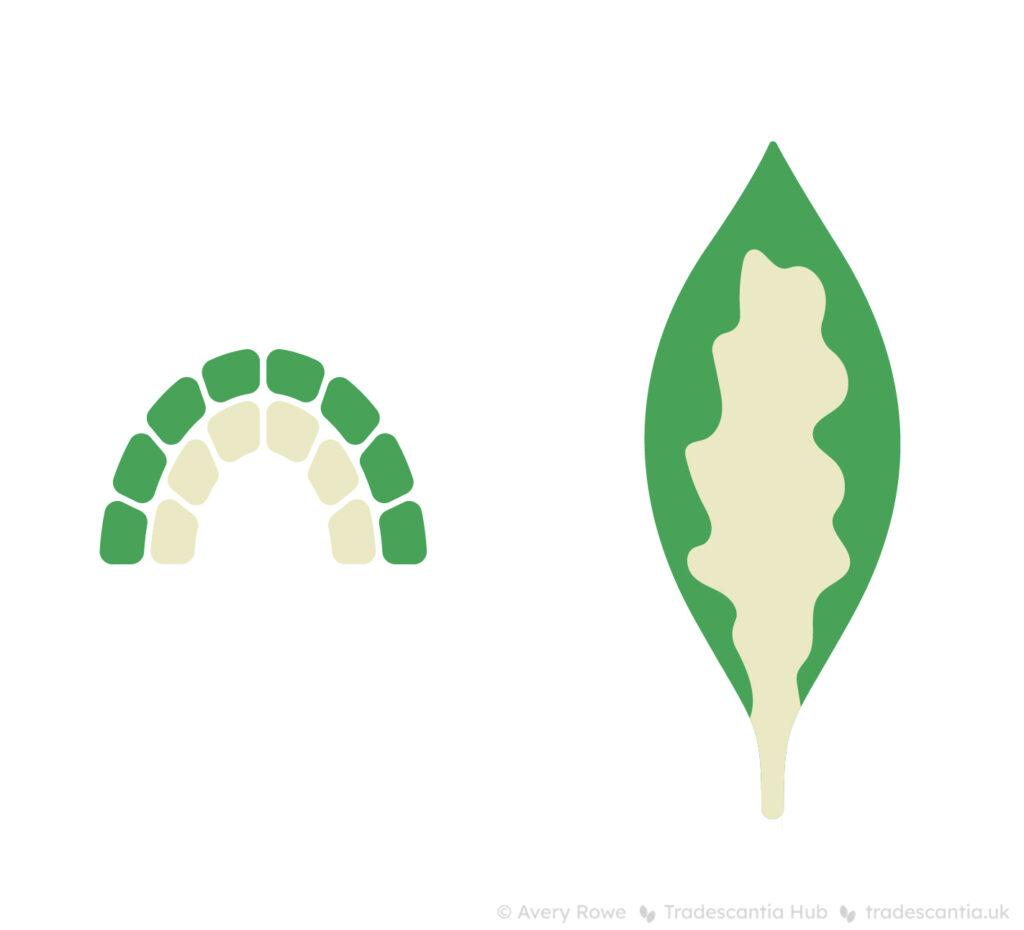
Sectoral chimeras
Some chimeras don’t have the normal and mutated cells divided neatly between the layers of the meristem. Instead the cells are distributed randomly, with a mixture of normal and mutated cells together in one or more layers. (In technical terms, a chimera is called mericlinal if the mutated cells are only mixed into some of the meristem layers, and sectoral if they are mixed into all of the layers. These types generally look the same at a macroscopic scale, so I’m grouping them together here.)
The cells can be mixed together in any arrangement within the layers. There could be anything from one single normal cell, to one single mutated cell – or any amount in between. The resulting leaf patterns are extremely variable. There can be large blocks of colour, stripes, streaks, or speckles. And unlike a periclinal chimera, this pattern is not regular or predictable. The mixture of the two types of cells is constantly changing from one leaf to the next, and so are the resulting leaf patterns.
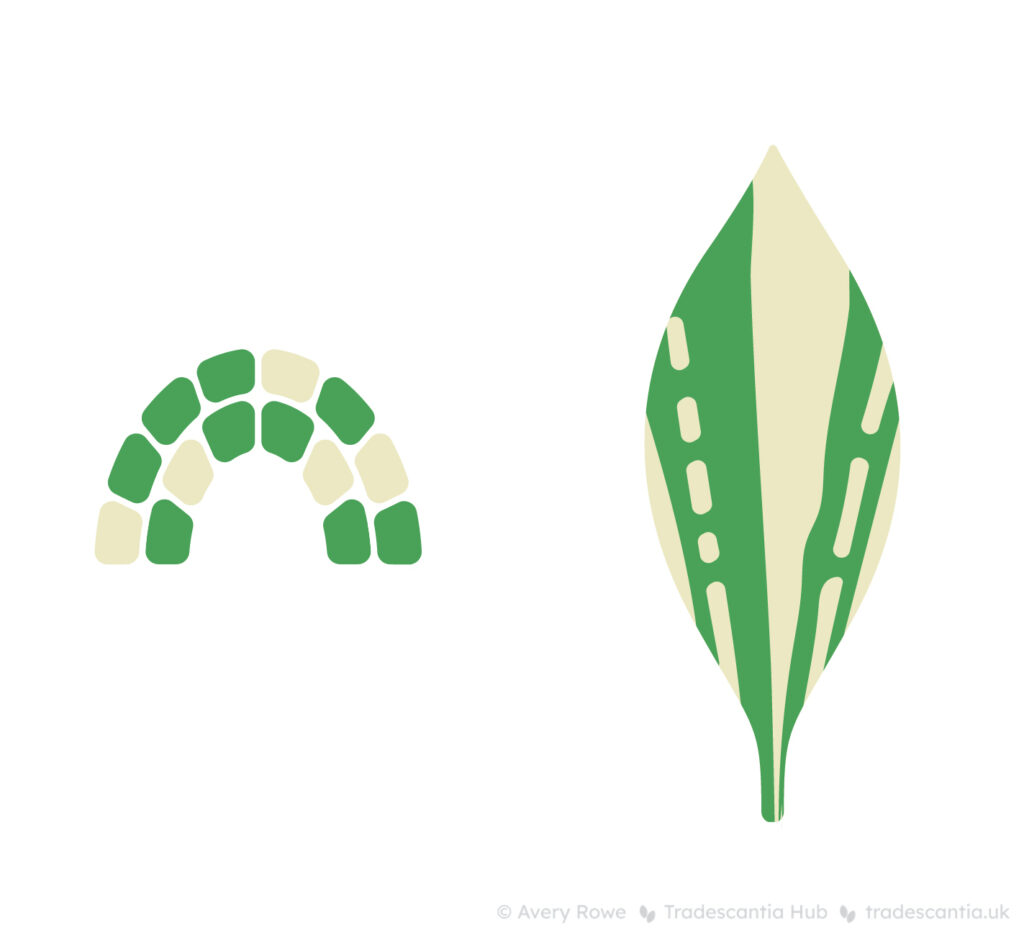
Environmental conditions
Genetics are an essential factor in defining the way a plant grows and develops. But they don’t tell the whole story. Plants are also constantly reacting and adapting to their environment, in order to best survive the conditions around them. They can be affected by lighting, airflow or wind, humidity, soil moisture, temperature, nutrient levels… and the list goes on.
If you get thirsty or cold, you can easily get up and go find a drink or a warmer place to sit. Most wild plants don’t have that luxury. They are rooted into the ground, and they’ll stay in exactly the same place for their entire life. So if something happens in their environment that’s harmful or dangerous, they have to adapt to cope with it in order to survive. Plants have evolved countless different ways of adapting to the conditions around them, and some of those ways involve changing their pigments and patterns.
Pathogens
The world outside of a plant contains more than just weather conditions to tolerate. There are some microorganisms – like fungi, bacteria, and viruses – that can enter plants and infect them.
Any pathogen can only affect certain types of plant. Some cause no symptoms at all and go unnoticed. Some are invariably fatal. And there is a wide range of possible effects in between, from severe damage and reduced productivity, to harmless colour changes.
Common types of variegation
So far, most of this article has been a fairly abstract explanation of how and why colour and variegation happens in plants. That overview is important to be able to understand what’s happening in a variegated plant.
But now I’m going to cover some specific types of variegation commonly found in cultivated plants. For each type, I’ll explain their how and why in the context of the explanations above. I’ll give well-known examples of each type, along with how to recognise them, and what they’re actually like to grow.
Structural variegation
Structural variegation is what gives certain species a pattern of shiny silver marks on green leaves. The marks are structural colours, usually created by the presence of air gaps between layers of cells in the leaf (structural variegation is sometimes called “blister variegation” for this reason). The underlying cause of the pattern is the genetics of the species, with some potential variation from the genetics of the individual.
Some familiar examples:
- Tradescantia zebrina (inchplant)
- Scindapsus pictus (silver or satin pothos)
- Pilea cadierei (aluminium plant)
- Peperomia argyreia (watermelon peperomia)
- Anthurium clarinervium (giant laceleaf plant)
How to recognise structural variegation
The most recognisable feature of this kind of variegation is simply the appearance of the coloured areas. There is nothing except structural variegation which can cause the same glittering iridescent silver on leaves. So if you see that shimmer, you can be pretty certain you’re looking at structural variegation.
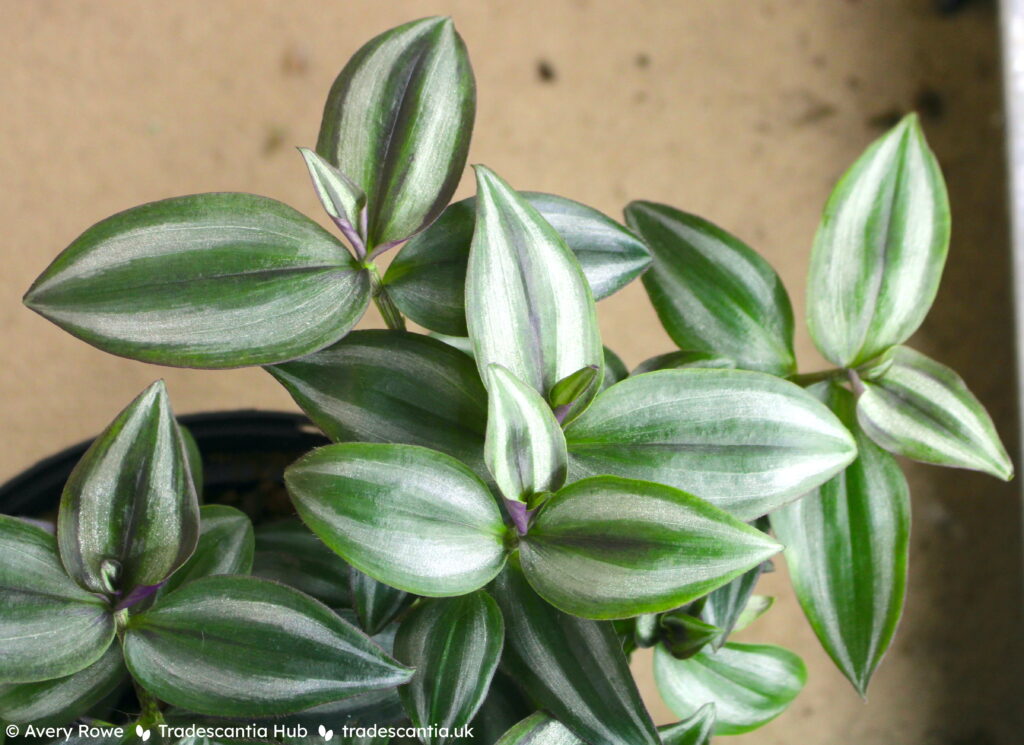
Because structural colours are complex to create, they’re only found in species which have evolved them for some survival reason. There are no mutant cultivars or sports which have structural variegation if their ancestral species didn’t. That means structural variegation will always be present in every specimen of the species, wild and cultivated.
In some cases there’s slight variation between flowering and non-flowering growth in the same plant. And different cultivars of a species may have silver areas in a slightly different size, shape, and layout. Very occasionally, there are cultivars which have mutated to lose the structural colours that are inherent to the species. But overall, the fundamental genetic pattern is always there.
Can structural variegation revert?
Because structural variegation patterns are inherent in the genetics of the species, they can never revert. No amount of mistreatment will cause a satin pothos plant to lose its silver blotches, or a watermelon peperomia to lose its watermelon stripes. Species with these patterns make popular ornamental plants because they have visually interesting foliage without the need for careful pruning and management to maintain it.
Can structural variegation be propagated?
These patterns are passed on through all methods of propagation.
The genetics of the individual plant are maintained through cloning techniques like cuttings or tissue culture, so those methods will produce identical offspring with the same pattern.
Structural variegation will also be passed down through seed. The pattern is fundamental to the species, and a seedling always belongs to the same species as its parents, so it will inherit the same genetic pattern. Because seedlings have their own unique mix of genes, they may have slight variations in appearance compared to their parents and siblings. This is how plants can be selectively bred for particular desirable patterns.
Species-specific pigments
Species-specific pigment patterns can be a range of colourful stripes, bands, spots, or blotches. The different coloured areas are created by different combinations of chlorophyll and non-photosynthetic pigments. The underlying cause of the pattern is the genetics of the species.
Examples you might recognise:
- Many Marantaceae species (prayer plants)
- Ludisia discolor (jewel orchid)
- Pelargonium zonale and its hybrids (zonal geraniums)
- Tinantia pringlei (spotted inchplant)
- Coleus scutellarioides (painted nettle)
How to recognise species-specific pigments
The appearance of the coloured areas can vary between species. In some cases there are red or purple pigments on parts of the leaf. In some there are light green or white areas with reduced chlorophyll. And in a few cases, both chlorophyll and non-photosynthetic pigments are arranged in patterns which may overlap to create multiple colours.
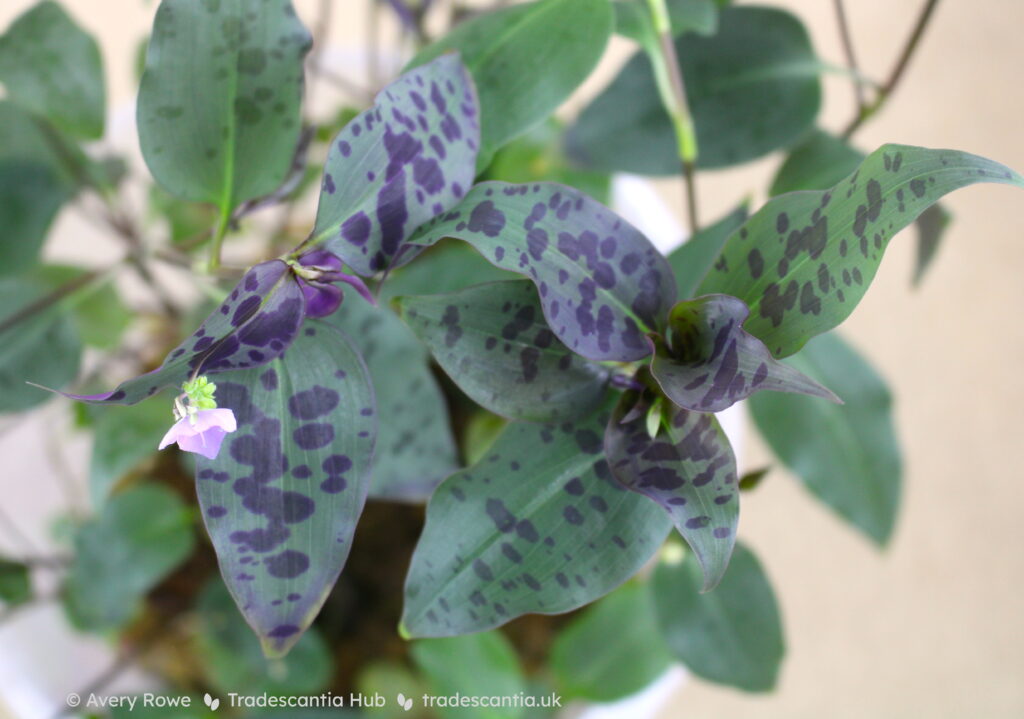
Like structural variegation, species-specific pigments have evolved for survival reasons, and are built into the plant’s genetics. That means every specimen of the species will have the same basic pattern, even if different cultivars may have brighter, darker, bigger, or smaller coloured areas. And in any individual plant, the pattern will be consistent in the same conditions – although there may be variation according to light level or flowering stage. So you can recognise species-specific pigments by observing that every plant of the species has the same or similar patterns.
Can species-specific pigments revert?
The genetic basis of the colour also means that, like structural variegation, these patterns cannot revert. In some cases, the patterns may fade and become almost invisible in certain growing conditions, but they will always come back. There’s no risk of the colour being permanently lost if the plant isn’t maintained properly, so these species make popular beginner-friendly variegated ornamentals.
Can species-specific pigments be propagated?
These patterns are passed on through all methods of propagation.
Just like structural variegation, the genetics of the individual plant cause the pattern. So methods like cuttings and tissue culture which create exact clones will always result in identical offspring.
The patterns are also passed down through seed, because it’s inherent to the genetics of the species. The seedlings will be genetically unique, which means they might have minor variations in appearance. Over multiple generations, these small variations can be selectively bred to change or improve them.
Albino chimeras
Albino chimeras create variegation involving a mix of typical green areas, and albino (white) areas. The colours are created by chlorophyll being absent from some parts of the leaf. The underlying cause is a chimera – a mix of mutated and non-mutated cells – where the mutated cells don’t produce chlorophyll.
How to recognise albino chimeras
Albino chimeras are some of the most widespread types of variegation in cultivated plants. They create a range of different patterns of variegation depending on the type, but the patterns always involve a mixture of typical green areas, and albino areas. I’ll give examples of albino chimera cultivars when I come to describing the two different types in detail.
It’s easy enough to recognise the presence of albino tissue in a leaf – with no green chlorophyll, it will be white (or if there are non-photosynthetic pigments present, anything from creamy yellow to bright pink). But as we’ve learned, knowing how the colours are created doesn’t necessarily tell us why things happened that way – there are multiple possible causes of variegation involving albino tissue.
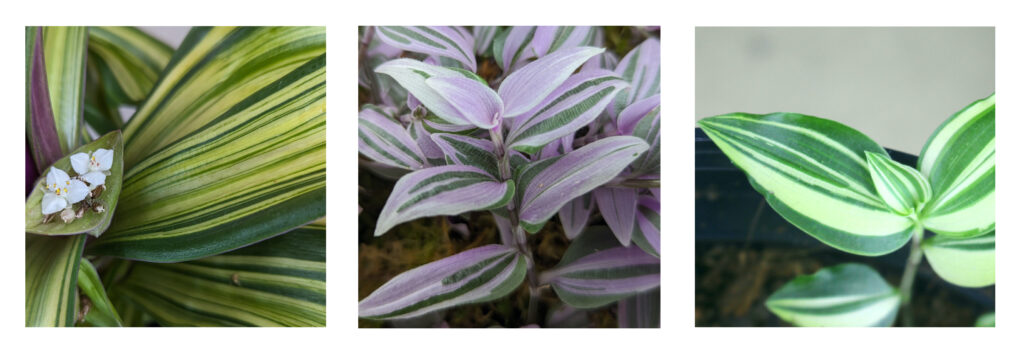
To be sure that a pattern is caused by a chimera requires some knowledge of the species in general. A chimera is a type of mutation, and by definition that means that it’s unusual compared to how the species normally looks. So if you see an albino pattern on a plant where all other cultivars and all wild specimens have solid green leaves, that’s a clear sign the variegation could be caused by a chimera. If you come across an albino pattern that seems to be present in every plant of that species, even in the wild, then it’s probably not a chimera (instead it’s most likely a species-specific pigment pattern).
Keeping albino growth healthy
When growing chimeras, it’s important to remember that albino tissue is inherently not good for the plant. That doesn’t mean it’s unethical or impossible to grow these cultivars (plants don’t feel pain and suffering in the same way as poorly-bred pets!). But it does mean that they will always be somewhat weaker and more delicate than their natural green counterparts.
Because albino tissue lacks chlorophyll, it can’t produce its own energy from light. It’s only able to survive because the green tissue in the rest of the plant is producing enough energy to share. Having to sustain this albino tissue with the energy produced from only some parts of the plant means it’s just much harder work to grow. And as a result, a plant with chimeral variegation will always grow more slowly than an identical pure-green plant in the same conditions. Brighter light can help compensate for this, by allowing the green parts to photosynthesise as efficiently as possible.
But bright light can also cause problems. Chlorophyll absorbs light energy and turns it into usable chemical energy. Without chlorophyll, all that light gets absorbed by structures that aren’t adapted to deal with such intense energy. And that in turn can lead to damage on the white parts of variegated leaves when grown in bright light.
So growing variegated chimeras is a balancing act between the two competing needs – bright light is important to sustain the albino tissue, but that bright light can also damage the albino tissue. Finding the sweet spot to keep the plant happy and healthy is a matter of trial and error.
Can albino chimeras revert?
All chimeras are inherently somewhat unstable. There are cells with two different sets of genetics in the growing tip of the plant. Depending on the type of chimera, they may usually stay in a fairly regular arrangement. But it’s always possible for them to get shuffled around as the stem grows. That can make the variegation pattern very changeable. And it can also result in one set of genetics being lost from the growing tip entirely, and the other one taking over. When that happens, it’s permanent, and the growing tip will never regain the other colour again.
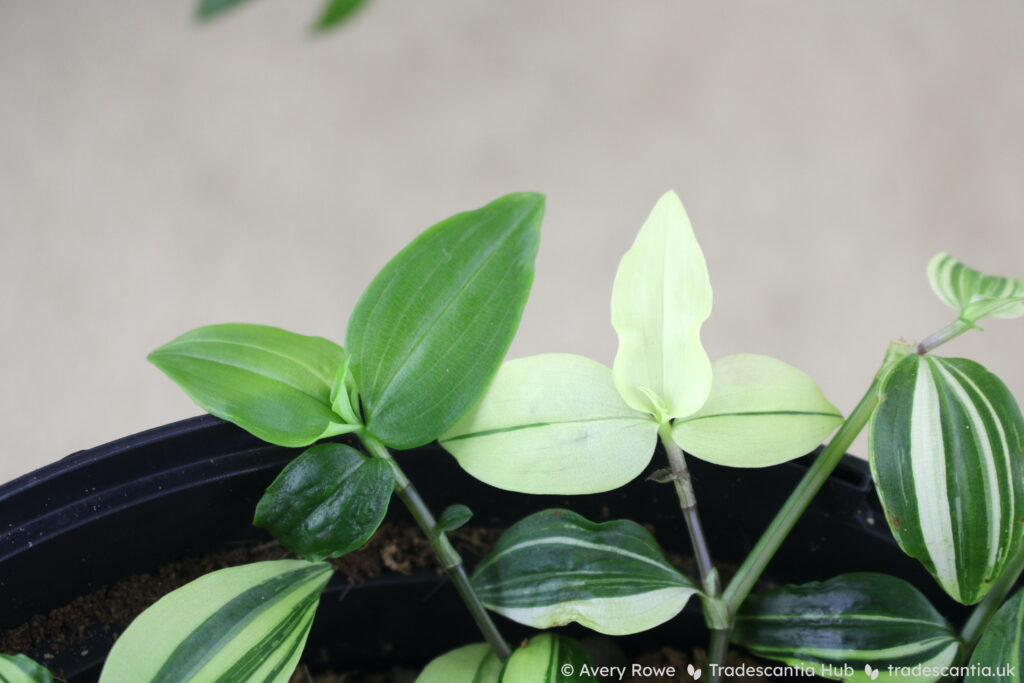
If the typical green growth takes over, it will start making pure green reverted stems. Because albino chimeras are weak, any reverted parts will grow faster and stronger than variegated parts. If left unchecked, the reverted growth will eventually take over completely and the variegation will be lost from the entire plant. But if the reverted growth is removed when it appears, then the plant can still make new variegated branches from the remaining variegated stems.
Less often, the mutated albino growth can take over and start making pure white (or yellow or pink) stems. This can look interesting and attractive at first. But as we know, albino tissue can’t sustain itself without chorophyll. So these pure white stems can only survive for so long on their own and will eventually weaken and die. As with solid green growth, if these stems are removed then the plant can make new variegated branches from lower down.
This all means that successfully growing a variegated chimera requires constant maintenance – and some luck.
Can albino chimeras be propagated?
Because the variegated pattern is the result of a mix of cells in the new growth, chimeras can be difficult to propagate successfully.
Stem cuttings are the only way to propagate variegated chimeras and maintain the mixture of cells in the growing point. But even cuttings aren’t guaranteed to succeed. The variable mixture in the meristem means that the new growth that forms from the bud on a cutting might be pure white or pure green. And there’s no way to predict or prevent that for certain.
Seeds from a variegated chimera will only have one set of genetics – which means every seedling will either be pure white (and die shortly after germinating, if it manages to germinate at all), or plain green. Tissue culture techniques which are used to mass-produce plants by cloning tiny leaf samples also usually have the same result, because any individual leaf sample can only grow into either a pure white or pure green plant.
Marginal albino chimeras
A marginal (or periclinal) chimera is one where the meristem contains neatly-separated layers of mutated and normal cells. The different layers in a plant’s meristem make up different parts of the leaves – some layers form the edges and some form the centres. With the mutated layers lacking chlorophyll, the result is one of two patterns on the leaves: either green centres with white edges, or white centres with green edges. Some familiar examples:
- Ficus elastica ‘Tineke’ (fig or rubber plant)
- Hedera helix ‘Glacier’ (ivy)
- Chlorophytum comosum ‘Vittatum’ (spider plant)
- Tradescantia cerinthoides ‘Nanouk’ (inchplant)
- Aeonium ‘Sunburst’ (tree houseleek)
The best clue for recognising this type of chimera is in the name – the variegation is marginal, meaning the margins of the leaf are one colour and the centre is another. Here are some examples of the two possible arrangements of marginal variegation.
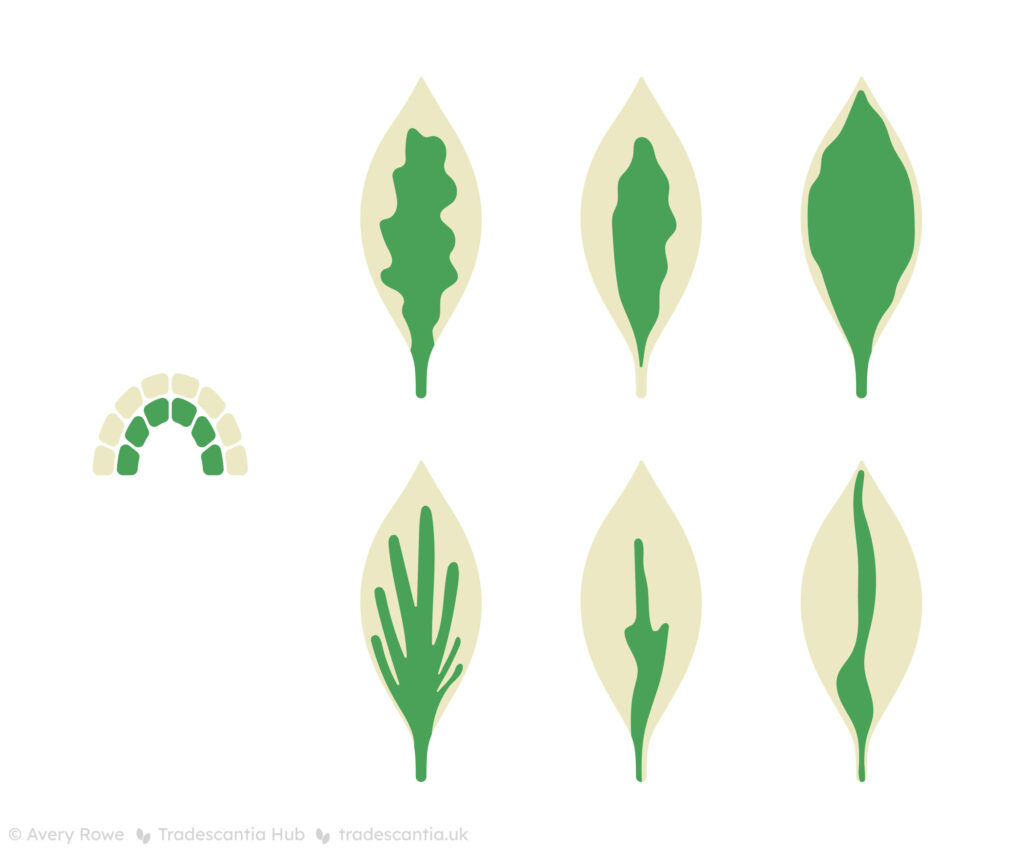
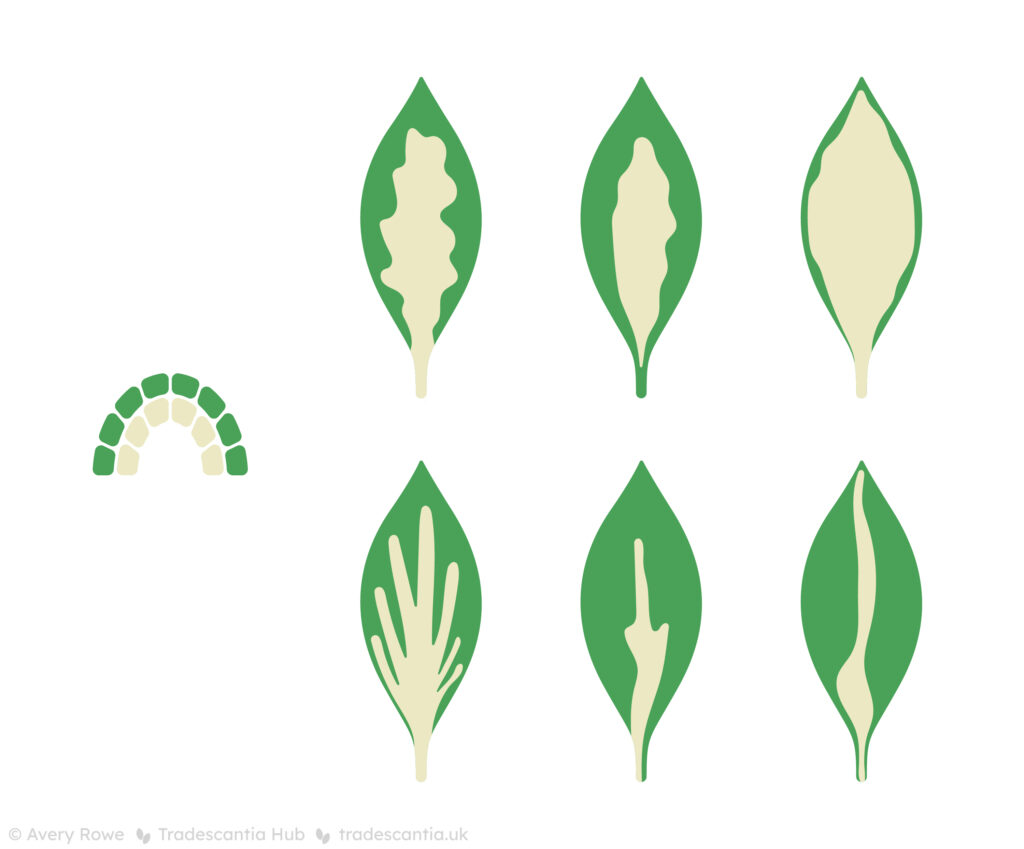
Sometimes the marginal pattern is very clear, with a neat crisp border around a defined centre. In other cases, it’s harder to recognise. The margin might be very narrow, so that it’s only just barely visible at the very edge of the leaves. The centre might be streaky or jagged in shape, so it can give the impression of sectoral stripes and disguise the fact that it never reaches the edge of the leaf. And sometimes there are areas of in-between colours where the green and white seem to mix, because of the way cells arrange themselves to form leaves.
One shortcut way to recognise a marginal variegation pattern is to imagine inverting the two colours on the leaves (or take a photo and actually do it!). If the result just looks like it could be some other leaf of the same cultivar, then it’s probably a sectoral pattern. But if the result looks like a completely different cultivar with a different colour arrangement, then you probably have a marginal pattern.
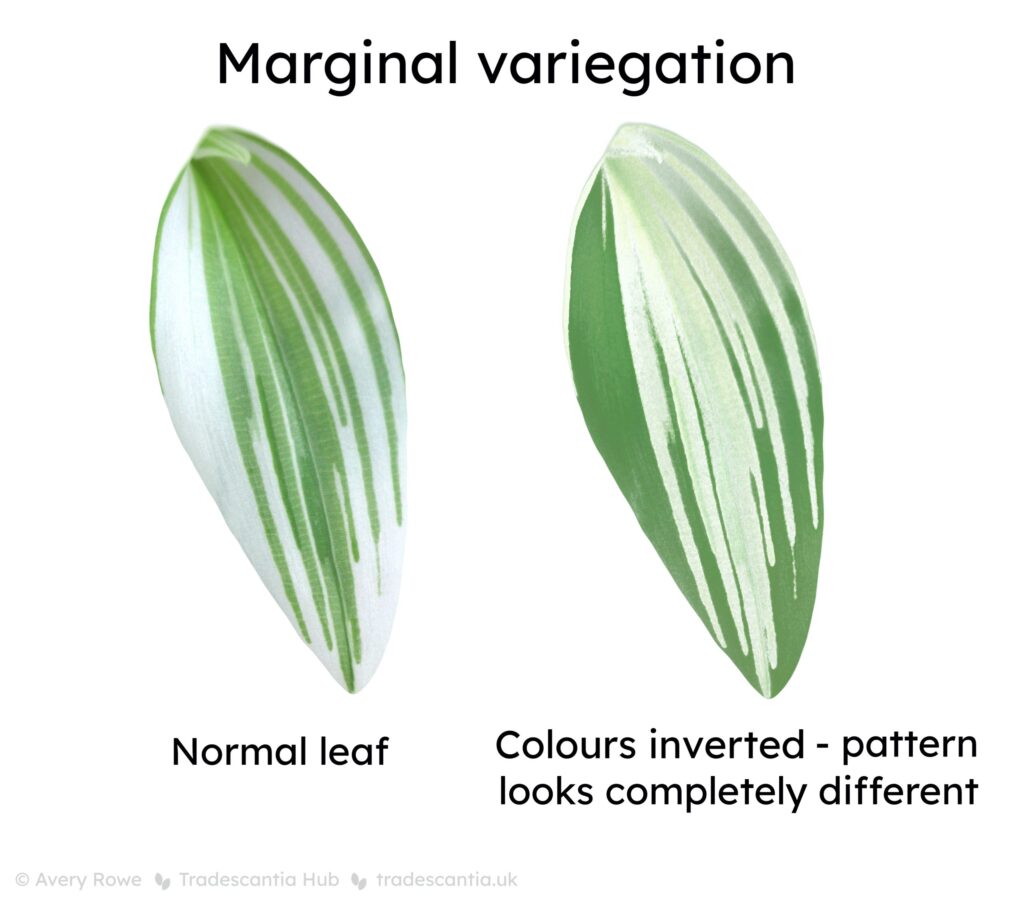
The organised meristem layers make marginal chimeras somewhat more stable than sectoral ones. They do have the ability to revert or become pure albino, and they can also mutate into sectoral chimeras. But none of those changes happen very often, because the layers usually stay well-defined and separated. This means they don’t require quite so much management and pruning to maintain the desirable patterns.
Sectoral albino chimeras
With a random mixture of green and albino cells across the meristem layers, there is no consistency to the patterns created by sectoral chimeras. The result can be narrow stripes, wide bands, tiny streaks and speckles, or anything in between. Some examples:
- Monstera deliciosa ‘Albo’ (variegated swiss cheese plant)
- Tradescantia fluminensis ‘Variegata’ (variegated inchplant)
- Many unnamed variegated plants which arose as sport mutations
The simplest way to recognise this chimera pattern is to rule out a marginal chimera. If the stripes of both colours sometimes extend all the from the base to the edge of the leaf, then it can’t be marginal – if it was, the edges of the leaf would always be one colour. Here are some examples of the random patterns sectoral chimeras can have.
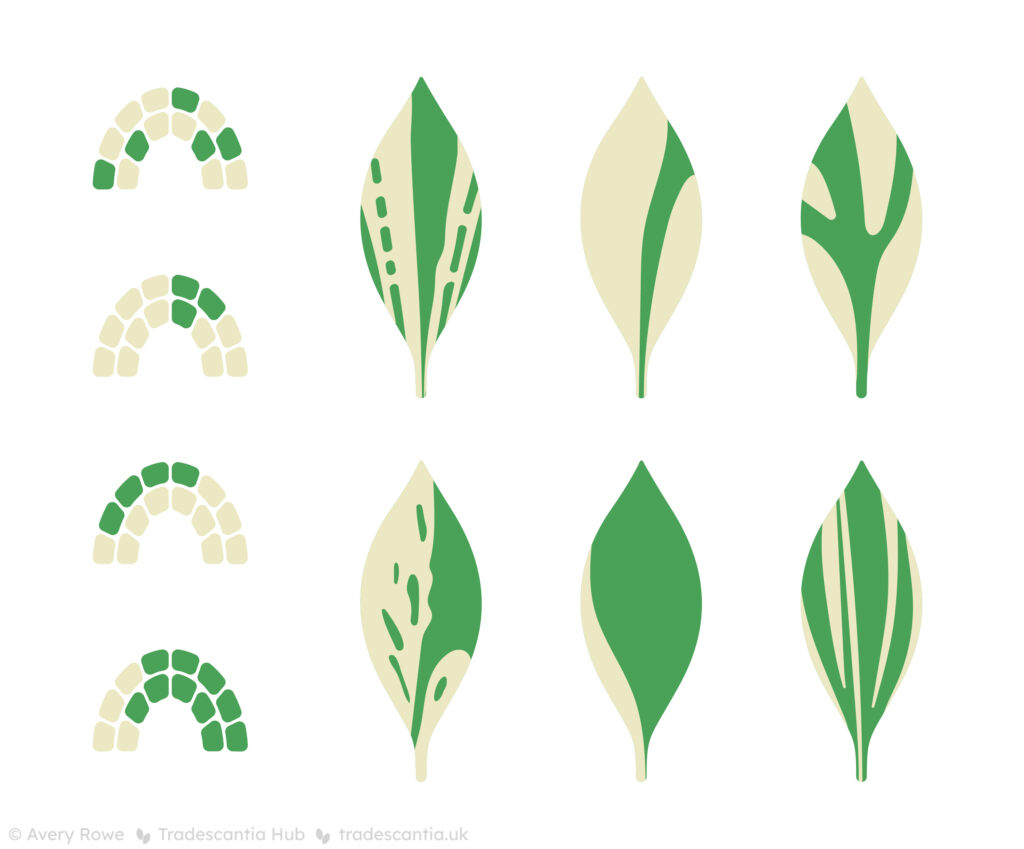
You can also use the colour inversion trick. If a colour-swapped version looks like a totally different cultivar, it’s probably marginal. But if swapping the colours makes it look like just some other leaf from the same plant, you probably have a sectoral chimera.
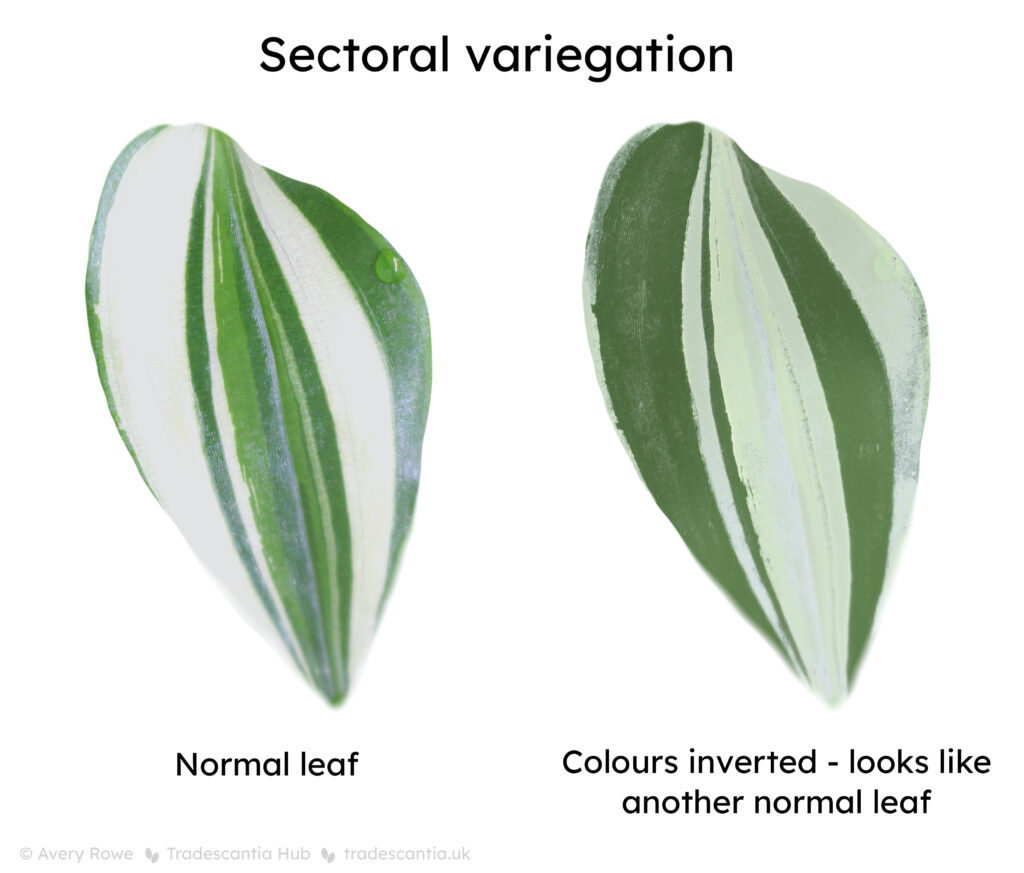
Another distinctive feature of sectoral chimeras is that the random mixture of colours is visible in the stem, not just the leaves. Any section of stem might look pure white, pure green, or have variable streaking with a mix of both.
The random arrangement of normal and albino cells means sectoral chimeras are the most unstable type. The balance and pattern of the two colour is completely unpredictable. Some growers find that getting the environmental conditions just right will help maintain a desirable balance. But in most cases, it’s random and uncontrollable.
Pure green (reverted) and pure albino stems are very common. In some fast-growing plants like Tradescantia mundula ‘Lisa’, those solid-coloured stems are so frequent that they’re considered a normal part of the cultivar’s appearance when sold. But long-term, the only way to keep the overall plant variegated is to be constantly pruning them away. In slower-growing and rarely-branching plants like everyone’s favourite M. deliciosa ‘Albo’, sometimes if a specimen starts making pure green or white growth it can simply never be salvaged at all.
Because of how difficult this maintenance is, sectoral chimeras tend to be less common in commercial growing. Mass producers don’t want plants that need half of their growth removed every month just to stop them turning into something entirely different! But that challenge and unpredictability also makes these plants popular with some enthusiastic growers. At any time, the trendiest rare houseplants are often sectoral chimeras that collectors found as sport mutations.
Stress colours
Stress colours are pink, red or purple areas, which appear and disappear predictably according to the environmental conditions. The colours are created with non-phosotynthetic pigments. These patterns arise through the interaction of two distinct causes. The plant’s genetics hold the inbuilt rules about when and how to produce pigments, and the environmental conditions trigger those inbuilt rules.
Some well-known plants which show stress colours:
- Many Tradescantia species, especially T. zebrina
- Many other succulents, like Echeveria and Crassula species
- Many carnivorous plants, like Drosera (sundews) and Dionaea (venus flytraps)
How to recognise stress colours
The pattern itself differs between species and individuals – the pigment may develop mostly at the edges or centre of the leaf, or in speckles or streaks. The pigment is triggered by physiological stress, conditions which are difficult for the plant in some way. The most common example is bright light, but cold temperatures and drought can also have the same effect.
The way that an individual plant develops pigment will always be consistent, but it won’t actually show up unless the environmental conditions are right. For example, if you take a greenish Tradescantia zebrina ‘Discolor’ and put it in intense direct sun, its new growth will develop red and purple streaks. If you take a green Tradescantia fluminensis ‘Viridis’ and put it in the same sunny spot, it will stay stubbornly green. Only ‘Discolor’ has the genetic wiring to produce pigments in bright sun.
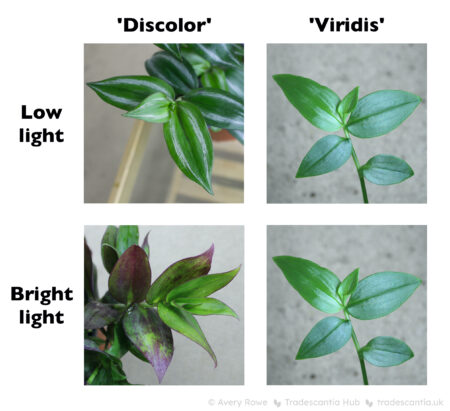
The environmental factor is the easiest way to recognise stress colours. No other form of variegation changes so directly and consistently in reponse to the growing conditions. If you have a plant which always develops the same red or purple marks in summer, and always loses those marks in winter – you can be pretty certain those are stress colours.
Is stress bad for plants?
Sometimes people worry about the term stress, and think that this means the plant is unhealthy or unhappy when showing non-photosynthetic pigments. But it’s not inherently a bad thing, any more than it’s inherently a bad thing when a plant is green from growing in shade.
Plants naturally adapt their growth depending on the conditions they’re in. If those conditions involve some external extreme like temperature or light, we call it stress. But the plant isn’t feeling pain or emotional upset like a human or animal might. It’s simply reacting to its environment to best survive it. Growers tend to find some of those reactions more attractive than others, but it doesn’t mean they are inherently good or bad.
As growers we can safely manipulate the environment within the tolerable range of conditions for the plant, to encourage the appearance we prefer. If the conditions become too extreme for the plant to handle, it will begin to show other symptoms like stunted growth and leaf loss. But if the only symptom is the changing pigment, then the plant isn’t being harmed any more than a human who becomes tanned in summer and pale in winter.
Can stress colours revert?
If a plant had purple streaks in the sun, and then became fully green when moved into the shade, it might be tempting to say it’s reverted. After all, it has lost a colour pattern that it previously had and become fully green.
But stress colours can’t revert, because the change is never permanent. The purple streaks weren’t a mutation that has been lost and returned to ancestral growth. Both the purple-streaked and plain-green forms are natural possibilities that exist in the plant’s genes. The environment defines which possibility is on show at any time, but that can always change when the environment changes.
So if you have a plant which has lost – or gained – pigments after a change in environmental conditions, it probably hasn’t reverted. If you want it to look different, try changing the temperature or light levels it’s exposed to. Chances are, its stress colours will change again within a few weeks or months. Over time you can learn how to get the growing conditions just right to maintain the look you prefer.
Can stress colours be propagated?
The rules which tell a plant when and how to develop non-photosynthetic pigments are genetic. So those genetic rules can be maintained by propagating through cuttings or tissue culture, and can also be passed down in seed.
But the propagated offspring will still need the same environmental triggers in order to actually show those stress colours. If you have a plant that developed a purple pattern in the sun, and you propagate a cutting to enjoy indoors, the attractive pattern will soon disappear as the cutting grows. The interaction of genetics and environment is always necessary to show the stress colours.
Mystery mutations
Mutations can involve an almost endless variety of different patterns involving yellow or white areas. Those light areas are created by a lack of chlorophyll in parts of the leaf, and the underlying cause is in the genetics of the individual plant.
A few examples:
- Tradescantia ‘Maiden’s Blush’
- Aucuba japonica ‘Variegata’ (spotted laurel)
- Tropaeolum majus ‘Alaska’ (variegated nasturtium)
How to recognise mystery mutations
There’s nothing universal about how mystery mutations look – the only thing they really have in common is that they don’t fit into any of the other categories. If you come across a peculiar plant with an albino variegated pattern which isn’t present in every specimen of the species, and doesn’t match the look of a chimera, it’s probably an individual mystery mutation.
Some of these mutations create a very consistent pattern, and others are variable. In some cases, the variegation might seem to disappear in certain conditions. For example, T. ‘Maiden’s Blush’ has a strange mutation which causes albino patches on the leaves only when the plant grows in cool conditions. In warm weather, it becomes pure green. But even if the pattern temporarily disappears, the mutation is still present throughout the plant. If a pure green ‘Maiden’s Blush’ is moved into a cool spot, within a few months it will spontaneously start making white patches again.
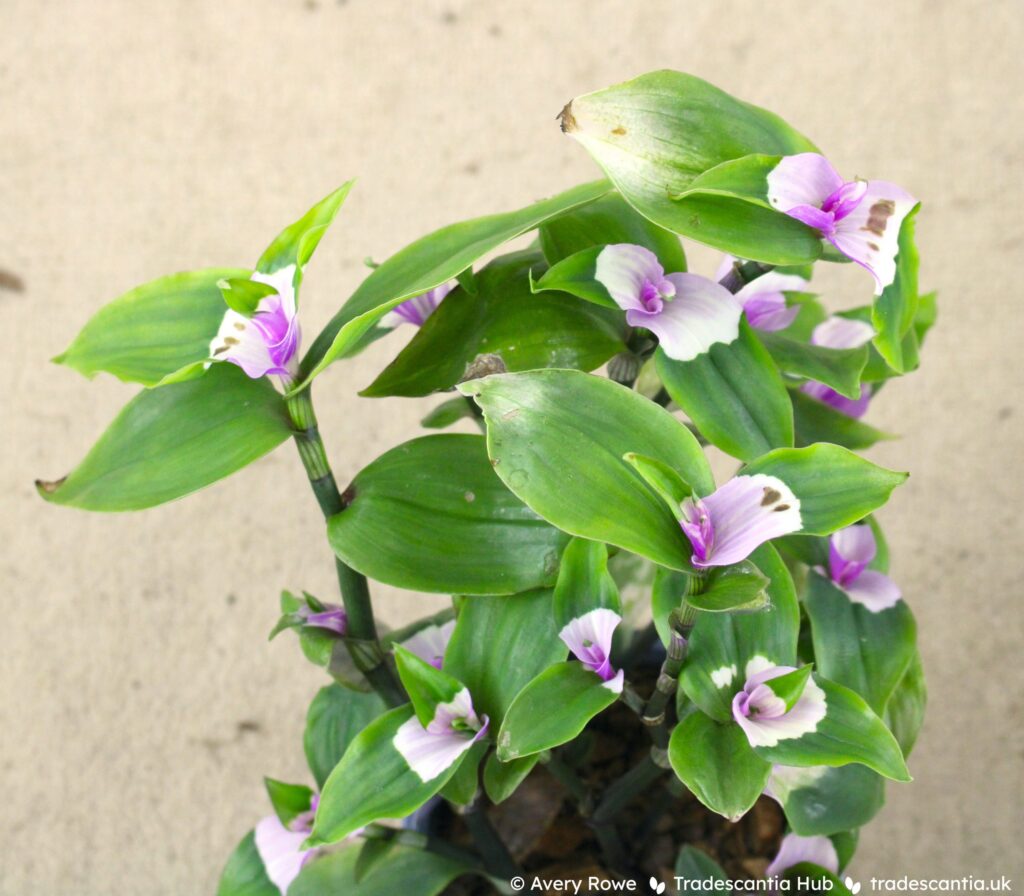
Can mystery mutations revert?
With the pattern inherent to the whole plant’s genetics, it’s not possible to revert permanently.
Some mutations involve patterns that appear and disappear in different conditions, like ‘Maiden’s Blush’. But this isn’t reversion, because the change is not permanent – the genetic mutation is still there, and the variegation can return if the conditions change.
Can mystery mutations be propagated?
Because the mutation is in the plant’s genes, any method of propagation that creates exact clones will maintain the pattern. Cuttings and tissue culture are both effective at making exact copies of a variegated mutation.
The genetic mutation also means that these patterns can often be passed down through seeds. If you find a variegated plant which can be reliably grown from seed (like variegated nasturtiums, which are a popular garden annual), you can be sure the pattern is in the genes and not caused by a chimera. Plants with genetic patterns can be selectively bred to create new and varied offspring with the same mutation.
Nutrient imbalances
Nutrient imbalances show various different patterns of chlorosis on the leaves. The yellowing is created by unhealthy cells losing chlorophyll, which is caused by specific environmental conditions.
I don’t have any examples of this type of variegation, because there aren’t any cultivars which permanently have nutrient imbalances! Any plant can show chlorosis in the right (or rather, wrong) conditions.
How to recognise nutrient imbalances
If a plant can’t get the right nutrients, it will struggle to produce and maintain healthy chlorophyll in its leaves, and parts will start to yellow. Depending on the nature of the nutrient problem, the chlorosis will generally have a regular pattern, either along the veins (veinal) or between the veins (interveinal).
Nutrient imbalances can happen for various reasons. Growing hydroponically – in just water with no soil – is a common culprit. Without soil to act as a buffer, it’s very easy for nutrient levels in the fertiliser solution to go wrong. Plants can become nutrient deficient if they have been growing in the same pot of soil for a long time and have exhausted any supply that was originally there. Even in fertile soil, if the acidity isn’t suitable for the plant it may be unable to absorb the nutrients that are present.
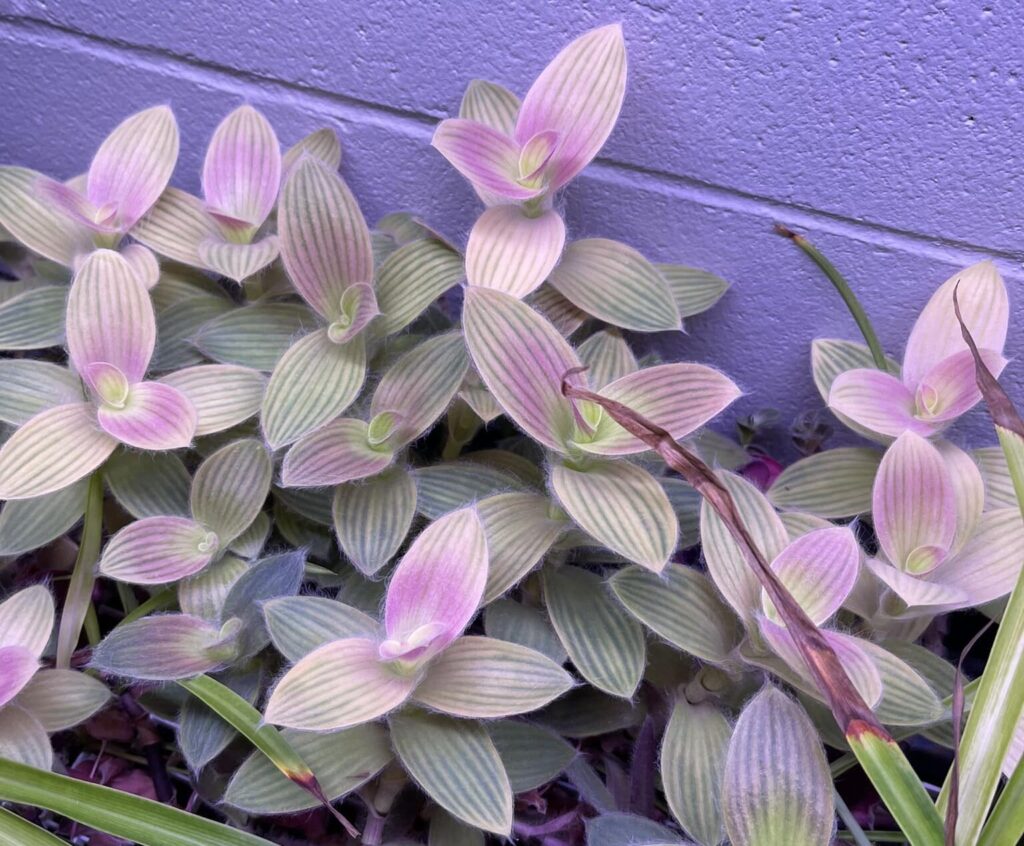
The yellowing will first start by affecting either all the newest leaves, or all the oldest leaves on the plant at once. This is a good way to rule out sport variegation. A sport develops from a single cell, which means that the new mutation will start at one particular spot on one particular stem, and develop from there. If a pattern shows up on many different stems all at once, it can’t be a sport mutation – so it’s more likely to be something caused by the environment, like a nutrient problem.
These patterns can sometimes look quite attractive, but it’s not a good idea to try and induce or maintain them on purpose. If the nutrient problem isn’t corrected, the plant’s growth will slow down or stall completely, and it will eventually die. Although nutrient imbalances are not considered a desirable type of variegation, it would be remiss not to cover them in this article. It’s just another reason that leaves can change colour, after all.
Can nutrient imbalances revert?
Just like stress colours, nutrient imbalances are caused by environmental conditions. If those conditions change, the visible symptoms of the nutrient imbalance will disappear. But if those conditions change back, the symptoms will return just the same. So they don’t revert permanently in the sense of mutations which can be lost for good.
If you have a plant that starts to show chlorosis because of a nutrient imbalance, correcting the nutrient problem will stop the chlorosis. Leaves which are already yellowed won’t turn green again, but new growth will go back to normal.
Can nutrient imbalances be propagated?
Nutrient imbalances are caused entirely by the growing conditions of the plant, so they aren’t maintained through propagation. If you propagate a cutting of a sickly nutrient-deficient plant and give it a balanced fertiliser, it won’t show the chlorosis pattern of its parent. Similarly, if you take a cutting of a healthy plant and deprive it of nutrients, the offspring will soon start to develop chlorosis.
Pathogen variegation
Pathogen variegation also involves chlorosis on the leaves. The chlorosis is created by cell damage which destroys chlorophyll, which in turn is caused by infection with microorganisms (usually viruses, which is why it’s often called “viral variegation”). This is a very uncommon cause of variegation, but there are a few well-known examples:
- Variegated Abutilon (flowering maple) cultivars caused by Abutilon mosaic virus.
- Variegated Camellia cultivars caused by Camellia yellow mottle virus.
- Variegated Hosta (plantain lily) cultivars caused by Hosta virus X.
How to recognise pathogen variegation
The pattern of chlorosis depends on the specific infection, but it may look like dots, streaks, blotches, or mottling. The only definitive way to confirm a pathogen infection is microscopic analysis to actually find the pathogen growing in the plant. Some types of infection can be fairly reliably recognised by particular visible symptoms, but others are vague and variable. And there are also many pathogens that haven’t been studied scientifically and might be completely unknown.
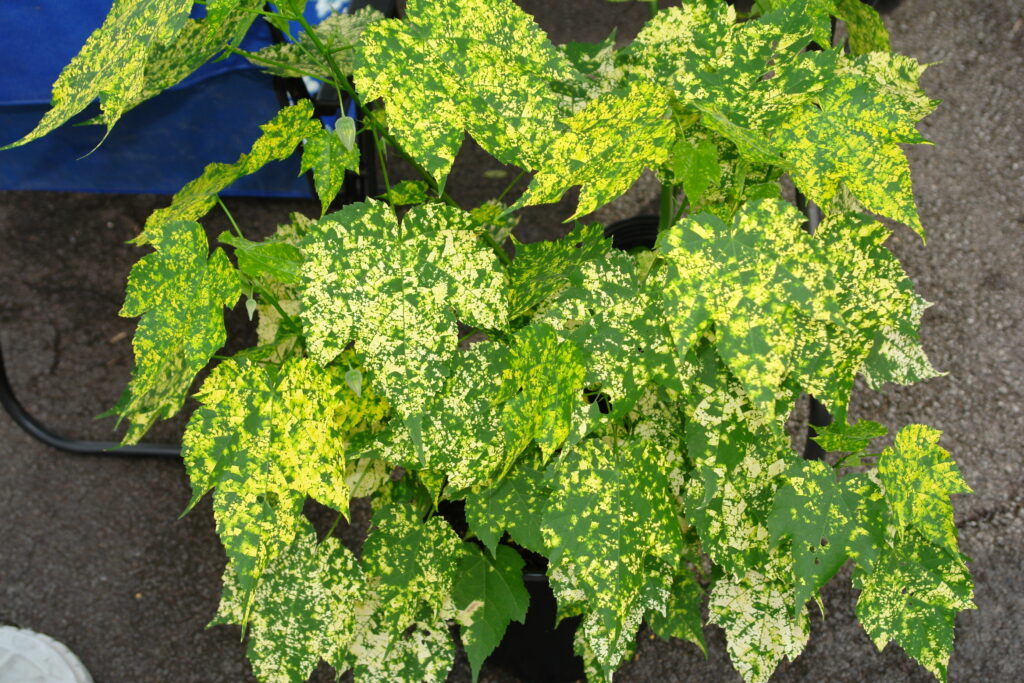
Plant pathogens are often transmitted through insects or other small pests, which carry microorganisms between plants when they feed – just like mosquitos can carry malaria. In some cases they are present in the environment, like in the air or soil, and find their way into the plant through injuries or weaknesses. Most pathogens can only affect certain species or groups of plant.
Some pathogens are fatal or cause severe damage. Others have no symptoms at all. And in the middle are a range of infections whose only noticeable symptoms are what looks like attractive variegated patterns.
Is pathogen variegation dangerous?
Although some plant viruses may cause few or no problematic symptoms, they should always be treated as potentially hazardous. Pathogen infections are by definition infectious and able to spread to other plants. And just like when bird flu spreads to humans, the infection may be far more dangerous to some species than others.
Plant viruses are always incurable. Once a plant is infected with a virus, it will have it for the rest of its life. Other types of pathogen (like fungi and bacteria) may or may not be treatable. But generally, an infection should be considered permanent.
Because of all that, horticulture professionals usually advise that plants with infections should be destroyed even if the symptoms are mild. You should only decide to grow a cultivar which is know to have a virus with full consideration of the potential risks.
This might all seem scary, but remember that plant infections are generally rare. In the vast majority of cases, if you notice strange damage or colour changes on a plant, it will have another cause like nutrient deficiency or pests. And although pathogens can be transmitted, they are often not very infectious. They might require specific conditions or a particular life cycle of a particular pest species to actually pass on the infection, or might only affect one plant species. So just having an infected specimen nearby doesn’t mean that every plant within a mile radius is doomed!
Plant pathogens pose very little risk to people and other animals. Plant viruses cannot infect animals at all. Some fungi and bacteria are generalists which can affect both plants and animals. But transmission of plant infections to humans is very rare and generally only a risk for people who are severly immunocompromised or otherwise unwell.
Can pathogen variegation revert?
Plant pathogens are generally permanent and will never go away. So any patterns caused by the infection are permanent too, and can’t revert.
Some infections have symptoms which vary over time or in different growing conditions. The weather may have an effect, and perennial plants often show symptoms differently throughout their yearly life cycle. But even when the symptoms change (or are temporarily invisible), the infection is still present.
Can pathogen variegation be propagated?
If a plant is propagated using cuttings, the pathogen will be passed on to the offspring. Tissue culture methods which propagate tiny sterilised samples of the plant may be able to produce offspring which are free from the infection. Some infections are transmitted through seed, but others aren’t.
Unlike any other cause of colour change, infections can also be transmitted to other plants. The pathogen can get from one plant to another through soil, via insects or other animals, and through contact with infected sap (like on garden tools). This is why it’s best not to keep or grow plants with pathogen infections. Even if the initial infected plant is unharmed (and may even have an attractive pattern), it has the potential to infect others and cause more damage.
Case study: Tradescantia zebrina ‘Discolor Multicolor’
It’s time to put all the information in this article into practise. Tradescantias are notoriously colourful and variable. After reading this far, you probably have an idea of why that is – pretty much every type of variegation I’ve discussed can be found in the genus. Not only that, but many cultivars have multiple different types of variegation at the same time. T. zebrina ‘Discolor Multicolor’ is a perfect example of that.

This plant has three different types of variegation at once:
I’ll go through them one at a time and show how to recognise them in this cultivar.
Structural variegation
The species is a pretty big clue for recognising this type of variegation. T. zebrina gets its name from its characteristic silver “zebra” stripes. It’s somewhat subtle compared to the other patterns on the leaves, but if we look closely we can see there are some silver areas. If we highlight the visible silver parts, we can see the overall pattern.
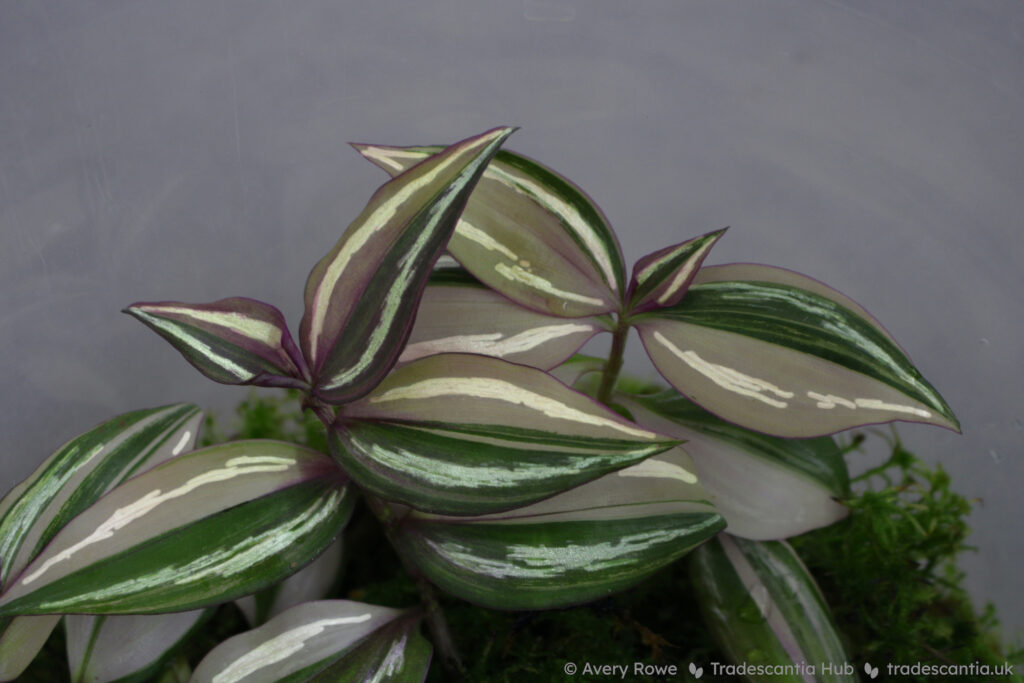
It matches the familiar pattern for this species, with two pretty much uniform bands on every leaf. As usual with variegation defined by the genetics of the species, the pattern doesn’t vary between leaves or in different environmental conditions. Although the silver bands are sometimes harder or easier to see, they’re always there in just the same way.
Sectoral albino chimera
Albino tissue is pretty easy to spot, and we can see the plant definitely has pale areas that don’t have any chlorophyll. We know that most T. zebrina specimens don’t have white parts like this, so we can rule out the species genetics as the cause. Highlighting the albino parts might help to work out what is causing this pattern.
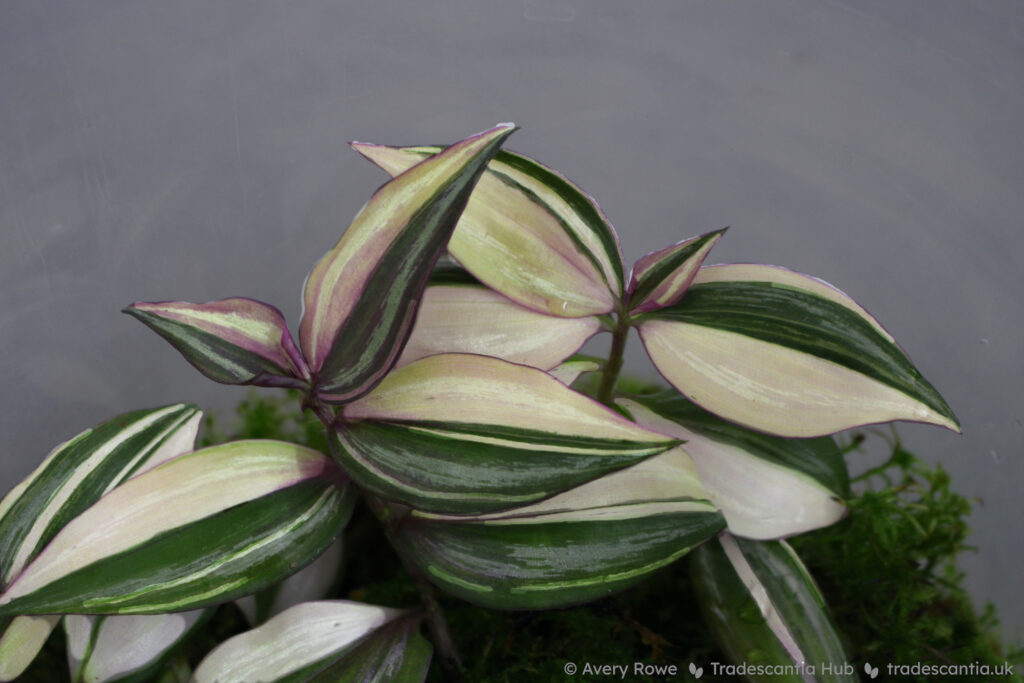
We can see that each leaf has a very variable amount of green and white in variable patterns. (I’m using “green” and “white” here to mean “chlorophyll is present” and “chlorophyll is absent”, even though as we can see, the resulting colours are changed a lot depending on the other traits). Each green or white stripe extends all the way from the base of the leaf to the edge, and there’s no regular border of a certain colour. This is a perfect match for the characteristics of a sectoral albino chimera.
Other than dissection under a microscope, a good way to confirm a chimera is to consider how the plant behaves in cultivation. Chimeras are unstable and prone to creating pure-green (reverted) and pure-white stems, and when those happen the other colour never comes back in new growth. If you’ve grown ‘Discolor Multicolor’ for a while, you’ll be able to confirm that it does behave that way, reverting fairly easily and not regaining its stripes when it does.
Chimeras are also not particularly affected by environmental conditions. Whether the plant is growing in a warm room under artificial lighting, or outside with blazing sun and cold nights, the pattern of albino parts varies pretty randomly just the same. Although the appearance of the albino sectors might change depending on the other colour factors (ones which are affected by the environment), the actual arrangement of parts with and without chlorophyll is unaffected.
Stress colours
It only takes a glance to see there there are clearly some red and purple pigments in the plant. We could have guessed this from the species too, since Tradescantia in general and T. zebrina in particular are known for often having intense non-photosynthetic pigments. There’s a pigment sheen over all the leaves, but here I’ve highlighted the boldest areas – streaks up from the leaf base and a border around each margin.
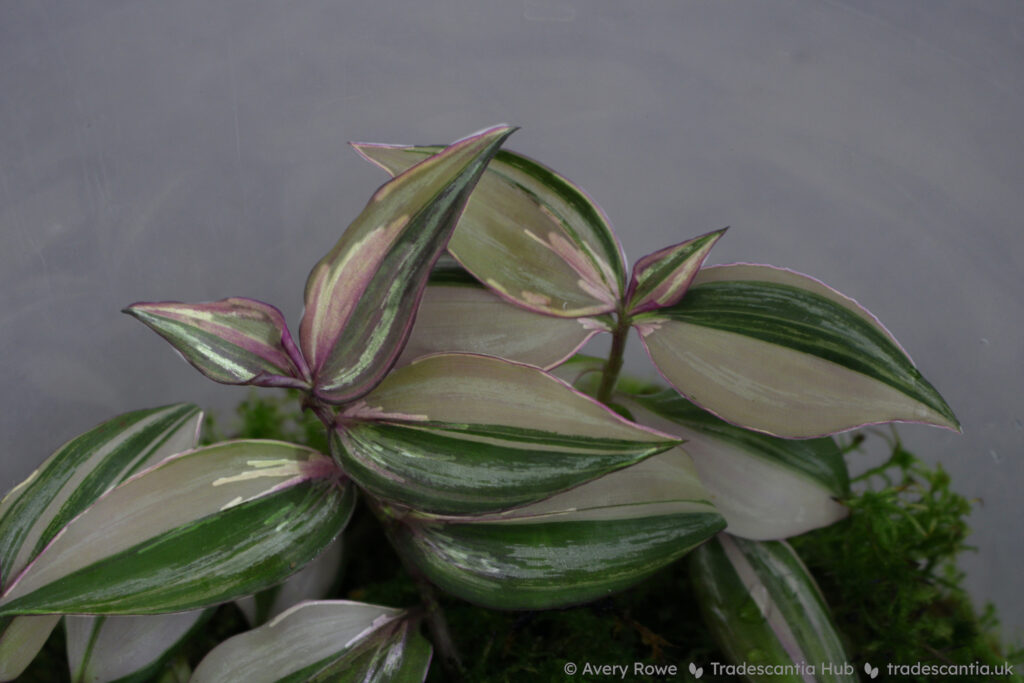
We know that all T. zebrina plants can have red or purple shades sometimes, so the genetics of the species seem to be involved. But there’s also variation between different cultivars – some develop red pinstripes, some become streaked or speckled in purple, some have a uniform dark stain. So the genetics of the individual plant must play a part too.
But that’s not all, either. Because even within one individual plant, like this ‘Discolor Multicolor’, the non-photosynthetic pigments can vary dramatically. When they are present, the green parts of the leaf become dark reddish purple, and the albino parts bright pink. But when they’re absent, the green parts are light and the albino sectors pure white or yellow.
If you’ve grown this plant yourself, you probably know the pattern already. The non-photosynthetic pigments show up when the plant is grown in high light, cold weather, drought, or other difficult conditions. They are stress colours caused by the interaction of environmental conditions and the plant’s own genetics.
Conclusions
This has been a long article! It had to be long to cover all the different types and causes of variegation. I hope that including this amount of detail has made things clearer than the usual oversimplified explanations.
There are three different traits which affect leaf colour in plants, and there are many different possible causes for patterns and colours. Putting those traits and causes together gives us many different specific types of variegation. Each type has its own how and why, as well as unique features in the way it can grow, revert, and be propagated. I’ll finish up with a table bringing all of those things together, as a summary to help recognise and identify different types. Links in the table lead back to other sections of the article which give more detail.
| Variegation type | How colours are created | Why colours are caused | Can pattern disappear or revert? | Can be propagated by… |
|---|---|---|---|---|
| Structural variegation | Structural colours | Genetics of the species | No | Any method |
| Species-specific pigments | Chlorophyll and/or non-photosynthetic pigments | Genetics of the species | No | Any method |
| Marginal albino chimeras | Chlorophyll | Marginal (periclinal) chimera | Yes, can revert permanently | Cuttings only |
| Sectoral albino chimeras | Chlorophyll | Sectoral chimera | Yes, can revert permanently | Cuttings only |
| Stress colours | Non-photosynthetic pigments | Interation of genetics and environmental conditions | Yes, can disappear and reappear | Any method if conditions are right |
| Mystery mutations | Chlorophyll | Genetics of the individual | Some can disappear and reappear | Asexually and maybe by seed |
| Nutrient imbalances | Chlorophyll | Environmental conditions | Yes, can disappear and reappear | Any method if conditions are right |
| Pathogen variegation | Chlorophyll | Pathogen infection | Some can disappear and reappear | Asexually, sometimes by seed, and transmissible |
Found this article helpful?
If you want more great resources like this, you can help me keep making them with a regular payment on Patreon.


5 replies on “Variegation and colour in plants”
Very good article but the page sizing is so off that all the images and the chart at the end is cut off and you can’t scroll unfortunately, I imagine the page breaks for mobile width are off
Thanks for letting me know, I’ve tweaked some CSS – how is it now? (you might need to clear your cache to see the updated formatting)
Excellent article, thanks! Great to see the level of detail and understand the various types of variegation
Enjoyed the article. While not a Tradescantia, some sansevieria( e.g. ‘laurenti’ ) varieties lose their variegation when propagated by leaf cuttings but retain them when simply divided. Could you comment on that?
It’s similar to the situation of propagating from seed. When a leaf cutting develops new growth, only a tiny area of cells form the new growing tip. So those cells will either all be green or all albino, rather than having the same organised layered mix found in the original growing tip or axillary buds.